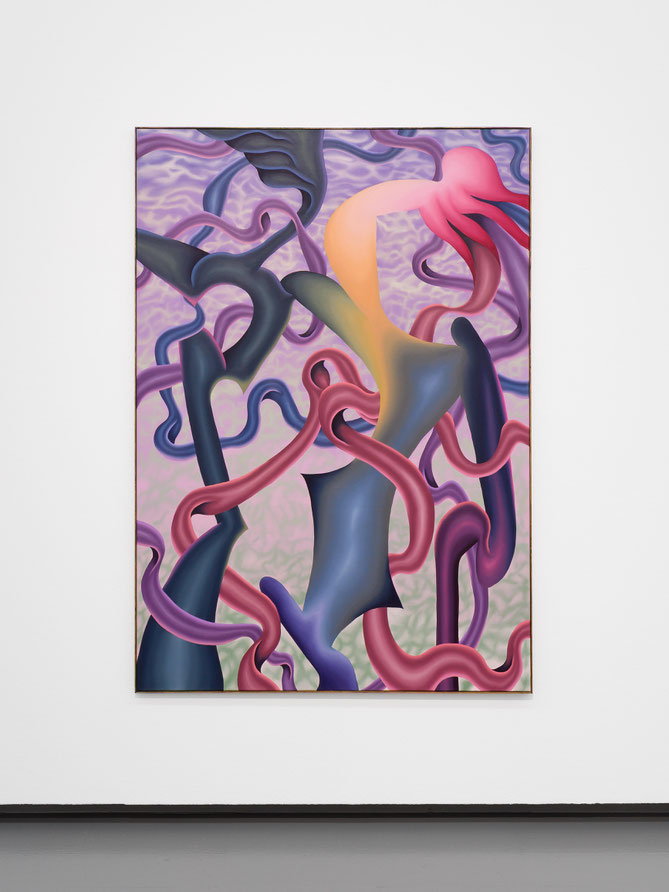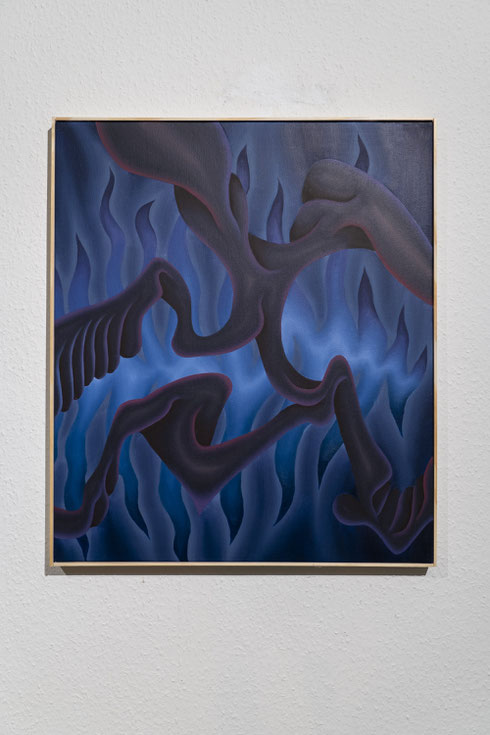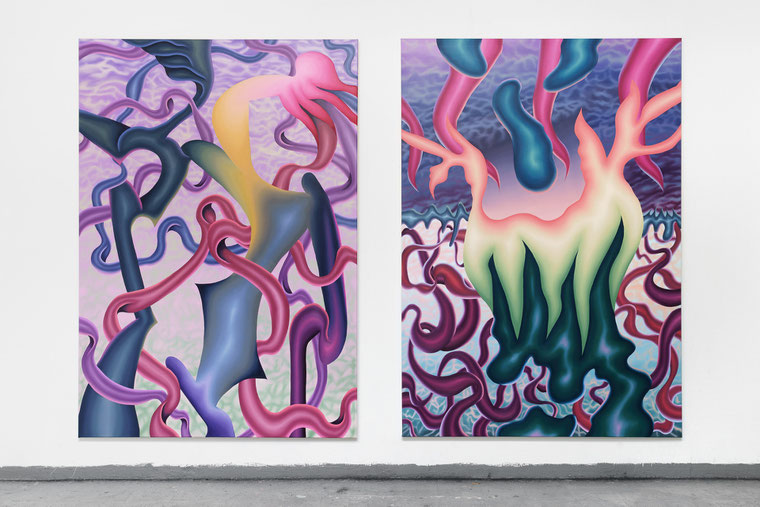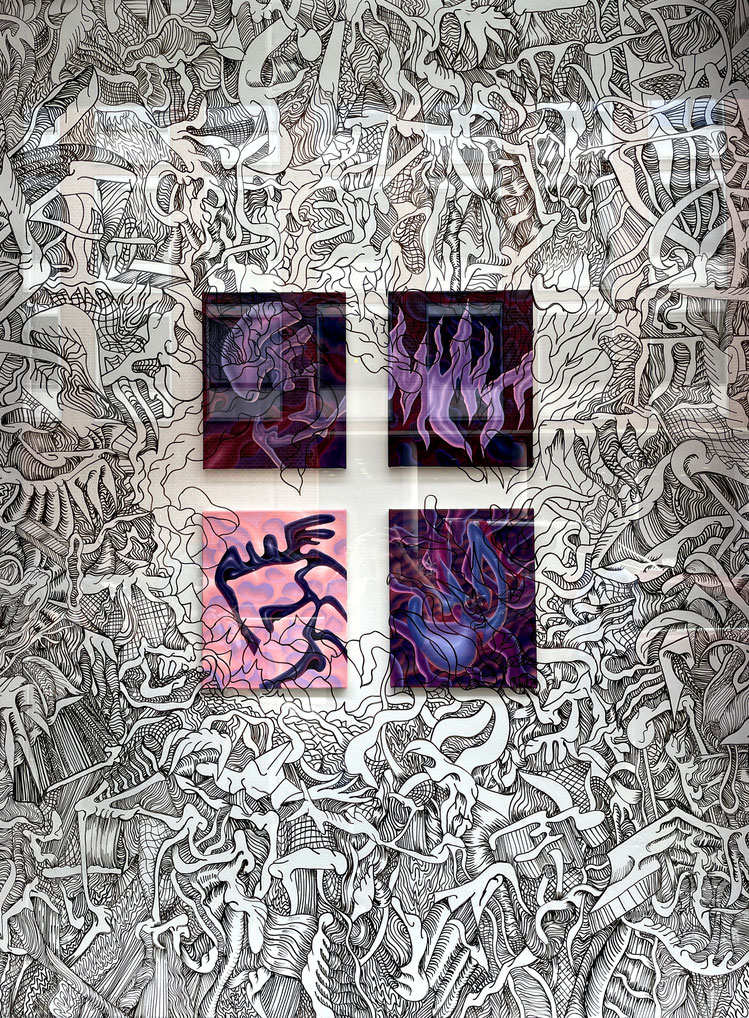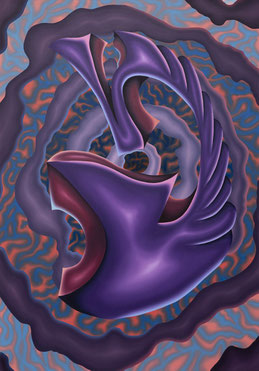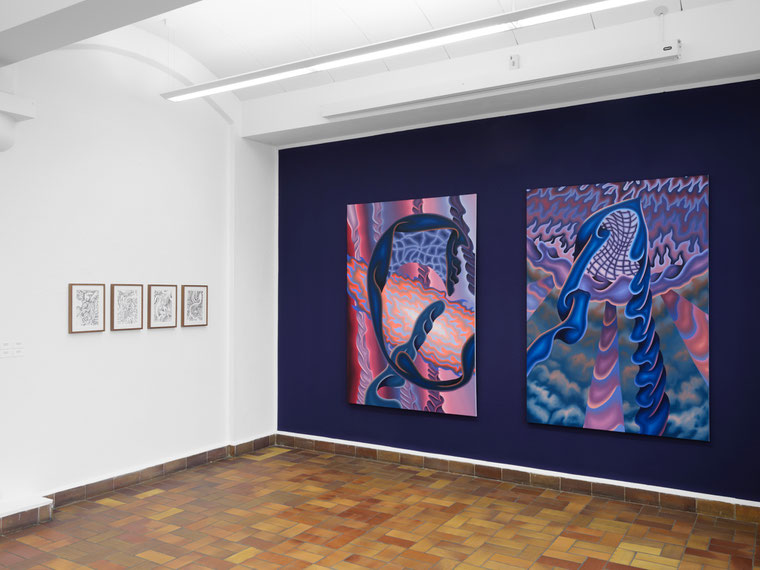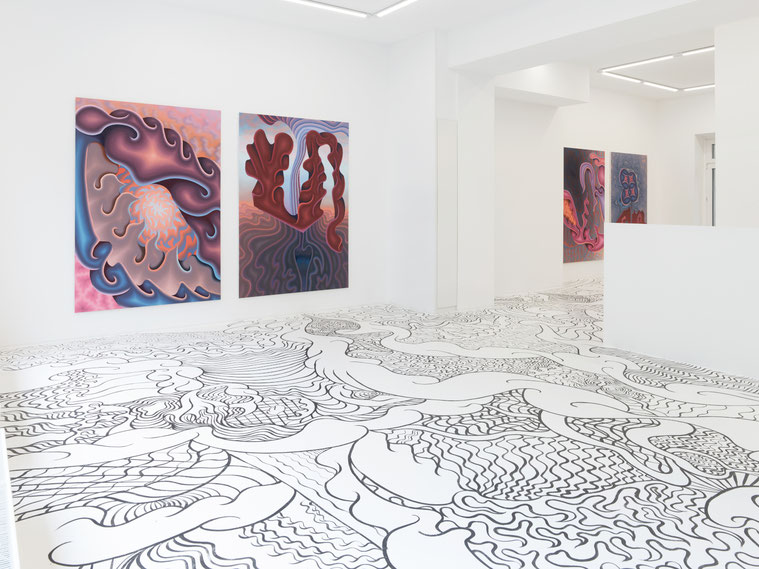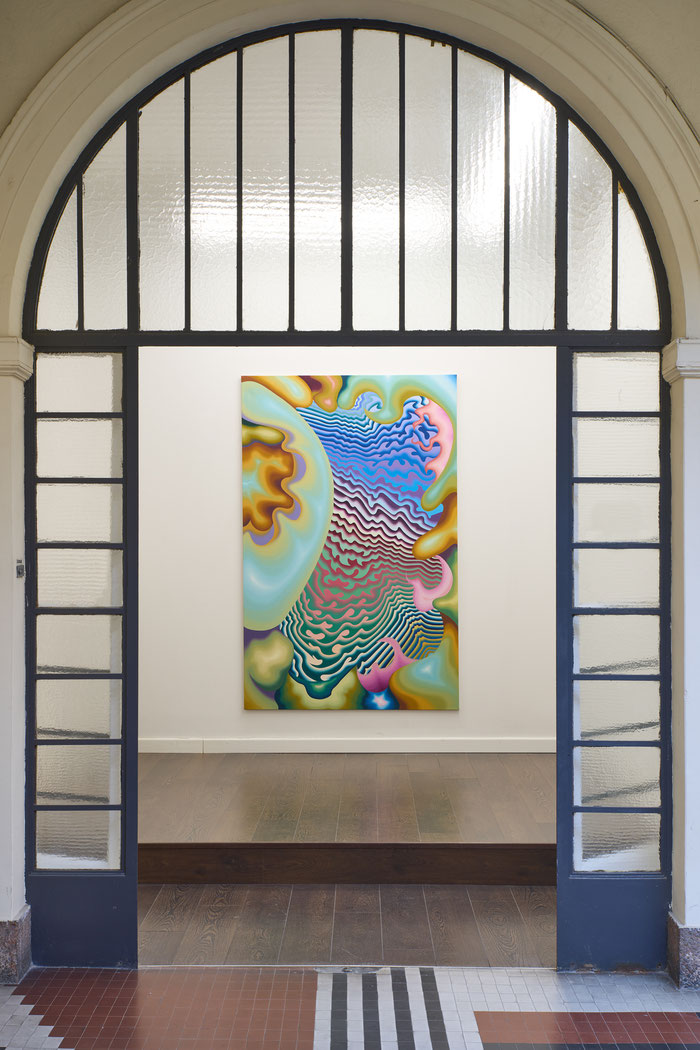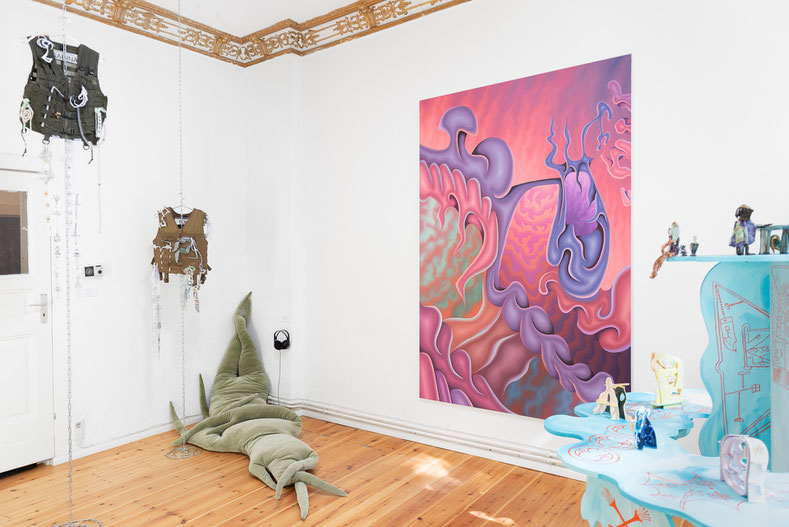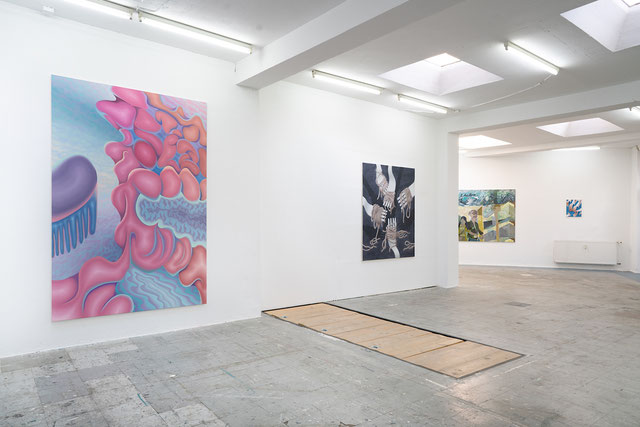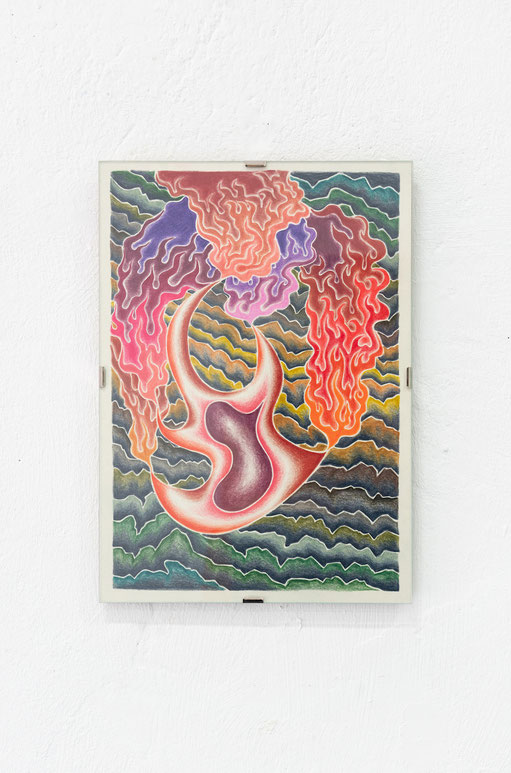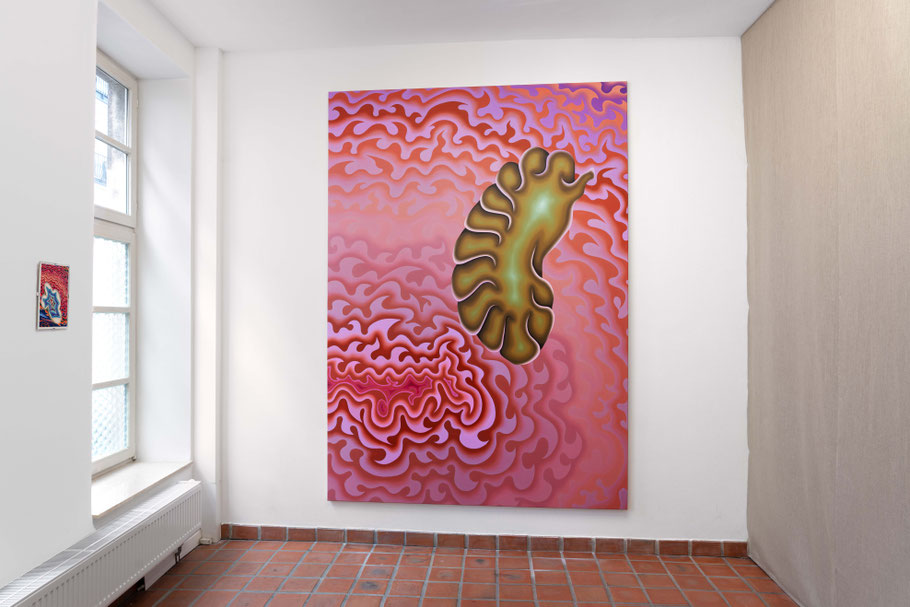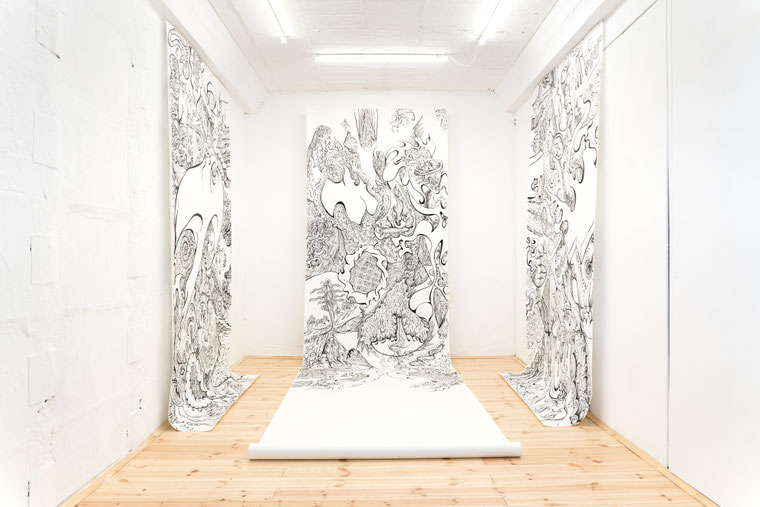Spooky Action at a Distance
Salon Galerie Droste, Berlin, BAW 2025




Spooky Action at a Distance
The title of the exhibition refers to Albert Einstein's famous concept of 'spooky action at a distance' –an invisible connection between particles that remains intact even over long distances. Antonia Freisburger came across this phrase in a podcast about quantum physics and was immediately fascinated by its ambiguity. The idea that particles could have feelings reveals a space in which physical phenomena and human experience merge. Her painting reflects precisely this ambivalence: it moves between the rationally incomprehensible and the emotionally deeply familiar. The artist herself describes this tension as a kind of "cosmic world-weariness" –a feeling between fascination and lostness, comparable to lovesickness. Love, like quantum physics, cannot be fully explained; it escapes logic and yet exerts its full force. Thus, painting here becomes not an illustration of personal stories, but an open resonance chamber in which individual feelings and collective questions intertwine. Spooky Action at a Distance deals with these invisible connections that cannot be rationally explained or controlled –bonds between people, feelings and memories. Some titles situate the works between pop culture and personal experience. Badlands I–III refer to a region in the Star Trek Universe that stands for danger and unpredictability, but also for places of refuge for rebels. Trennungsgrund, on the other hand, refers to the exploration of heartbreak, queer desire, and the breakdown of human relationships. In both cases, image titles become interfaces where individual experience, pop-cultural imagination and social reality converge. Spooky Action at a Distance thus refers to a fundamental attitude in Freisburger's work: taking the invisible seriously, tracing irrational connections and developing a special power precisely in this openness. Her painting shows that we are constantly entangled in relationships –relationships that cannot be grasped but nevertheless remain effective.
Der Titel der Ausstellung verweist auf Albert Einsteins berühmten Begriff der ‚spukhaften Fernwirkung‘ –eine unsichtbare Verbindung zwischen Teilchen, die auch über weite Distanzen hinweg bestehen bleibt. Antonia Freisburger stieß in einem Podcast über Quantenphysik auf diese Formulierung und war unmittelbar von ihrer Mehrdeutigkeit fasziniert. Die Vorstellung, dass Teilchen Gefühle haben könnten, öffnet einen Raum, in dem physikalisches Phänomen und menschliche Erfahrung ineinander übergehen. Ihre Malerei spiegelt genau diese Ambivalenz: Sie bewegt sich zwischen rational nicht Fassbarem und emotional zutiefst Vertrautem. Dieses Spannungsfeld beschreibt die Künstlerin selbst als eine Art „Weltraum-Weltschmerz“ –ein Gefühl zwischen Faszination und Verlorenheit, vergleichbar mit Liebeskummer. Liebe ist, wie die Quantenphysik, nicht vollständig erklärbar; sie entzieht sich der Logik und wirkt dennoch mit voller Kraft. So wird Malerei hier nicht zur Illustration persönlicher Geschichten, sondern zu einem offenen Resonanzraum, in dem individuelle Gefühle und kollektive Fragen ineinandergreifen. Spooky Action at a Distance behandelt diese unsichtbaren Verknüpfungen, die sich nicht rational erklären oder kontrollieren lassen –Bindungen zwischen Menschen, Gefühlen und Erinnerungen. Manche Titel verorten die Werke zwischen Popkultur und persönlicher Erfahrung. Badlands I–III knüpfen an eine Region aus dem Star Trek-Universum an, die für Gefahr und Unberechenbarkeit steht, zugleich aber auch für Rückzugsorte von Rebellen. Trennungsgrund wiederum verweist auf die Auseinandersetzung mit Liebeskummer, queerem Begehren und den Brüchen menschlicher Beziehungen. In beiden Fällen werden Bildtitel zu Schnittstellen, an denen individuelle Erfahrung, popkulturelle Imagination und gesellschaftliche Realität aufeinandertreffen. Spooky Action at a Distance benennt damit eine Grundhaltung in Freisburgers Werk: das Unsichtbare ernst zu nehmen, irrationalen Verbindungen nachzuspüren und genau in dieser Offenheit eine besondere Kraft zu entfalten. Ihre Malerei zeigt auf, dass wir unaufhörlich in Beziehungen verstrickt sind –Beziehungen, die sich nicht fassen lassen, aber dennoch wirksam bleiben.
Katharina Galladé, Galerie Droste
Die GROSSE 2025
Kunstpalast, Düsseldorf
Memory Lane
Ventana Space, Berlin, 2025
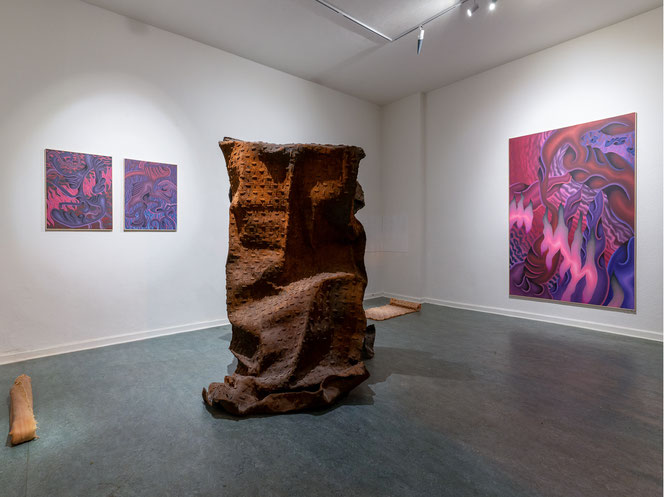
GARTEN EDEN
Kronen29, Düsseldorf, 2024
SYMBÖSIS
Lost Weekend, Munich, 2024
ART DÜSSELDORF
Galerie Droste, 2024
DO YOU GUYS EVER THINK ABOUT DYING?
Galerie Parterre, Berlin, 2024
DO YOU GUYS EVER THINK ABOUT DYING?
A portal in pastel red and blue tones emerges to the spectators of Antonia Freisburger’s painting Being able to feel nothing. It directs the gaze into a depth, whose extension remainshidden. Nevertheless, there is no absolute blackness lurking inside the portal, rather a greyish glow is rising out of it. Biomorphic forms surround its opening. They are of an intense, luminating color and deny any explanatory approach. It is impossible to say, whether we should speak of life forms or objects, both at the same time or neither of them. What we see, seems to be corporeal and disembodied at the same time and does not correspond to any physical condition known to us.
Freisburger’s paintings are soaked of movement. Their forms are hovering, floating, dripping, they are squirming, withdrawing, and sprawling. The dimension of the topics Freisburger presents to us in her pictures remains unclear. The fictionality of her imagery enables a localization in infinite widths as well as in the smallest of all microcosms. The representation could be billions of years old or only a few seconds, located in the past, present or future. Time and space remain unknown variables. The scenes Freisburger created are an expression of unstoppable transformation, recognizing in it the ambivalence of human affections and behavioral patterns. Thus, curiosity and the aim to comprehend the seen are accompanied by the need to categorize and domesticize the unexplainable. Freisburger’s sceneries appear auspicious and threatening at the same time, their potential is in their uncontrollability.
It is this curiosity, in which almost always a certain fear creeps in, leading us to the limitations of human imagination, which connects Freisburger’s art to science fiction. The genre made its mark on the work of a multitude of artists for a long time and exerts a continuous impact on theoretical discourse on contemporary culture, as art theoretician Dan Byrne-Smith puts it:
I hope to challenge the idea that science fiction can only be thought of as genre. Instead science fiction can be forms of practice, complex networks, or a set of sensibilities. It can be thought of as a field, a space of metaphor or a methodology. It resonates with ideas of change and uncertainty, as well as with the seemingly endless saturation of life by technology. It can also pertain to social unrest or new and darkening regimes of power. It speaks to those threats, anxieties and demands, providing opportunities to imagine new configurations. The importance of simple acts of imagining things as other than they seem cannot be overstated.
In the past decades science fiction developed an iconography of its own, which is significantly shaping our visual imagination about what might be. In the most astounding imaginations of parallel universes there are patterns and forms originating in our reality. Freisburger’s works are open to these associations and transfer them from fictive worlds to scientific theories and laws, whose visualizations overstrain our capability.
Thus, we can flip through a physics or math textbook to check the definition of string theory or infinity. But the images emerging in our minds, while thinking about these notions, have nothing to do with those theoretical models and explanations. These are exactly the images Freisburger is interested in.
The paintings of Antonia Freisburger follow an inner coloration created by the artist that determines the layout of each picture. In the relationship and the dispersion of colors Freisburger identifies something almost mathematical, thus, it is fixed right at the work’s beginning in which direction the color gradient will develop. From this sensed principle of order results a color harmony. The colors red, blue, purple, and orange are dominating, their warmth is enhanced by grey and pastel tones. Both colors and forms seem to pulsate. In her text for the exhibition High Weirdness (Solaris Space, Berlin, 2022) the artist Gosia Lehmann attributes a viscosity to Freisburger’s works. Beholding Freisburger’s paintings, Lehmann continues, is comparable to the feeling of being stuck in quicksand and going down deeper and deeper with every movement. Not many people come in touch with quicksand during their lifetime. It is an idea deriving from reading adventure literature or watching fantasy movies which despite of its improbability loses nothing of its uncanniness.
Also, for most people conceptions like infinity or nothingness remain exactly this: conceptions, whose reality we are conscious of, but whose extent remains finally abstract and incomprehensible. Antonia Freisburger’s paintings and drawings enter this gap, their objectivity reminds us to natural science but at the same time they own a dramatic mode that we perceive as emotionally charged and irrational.
Besides oil painting Antonia Freisburger is always working on small-sized crayon drawings. With respect to their topics and the artist’s biomorphic repertoire of forms the drawings resemble the paintings described above.
[…]
Through Antonia Freisburger’s pictorial worlds we enter surreal dimensions, in which we lack orientation and which like ghost images disturb our logic and rational sense. But there is something under their soft, smooth textures, which leads us out of the wilderness back to the inside, the subconscious. Emotions, dreams, and thoughts on identity were dismantled from their bodily shell by the artist and thus appear as external manifestations of themselves. No surprise at all, that while beholding her art we are confronted with the greatest of human primeval fears: The fear of our own mortality. Reverent and disenchanted at the same time we recognize in the imagination of the end our life also the futility to fully comprehend who we are and what surrounds us. Let us return once again to science fiction: Dan Byrne-Smith writes that it may serve to explore the limitations of being human in view of the non-human. Thus, Freisburger’s paintings are challenging and at the same time stimulating imaginations of the permeable, everchanging divide between the possible and the impossible.
Björn Brolewski
Galerie Parterre, Berlin, 2023
I've Got You
KIT - Kunst Im Tunnel, Düsseldorf, 2023 / 2024

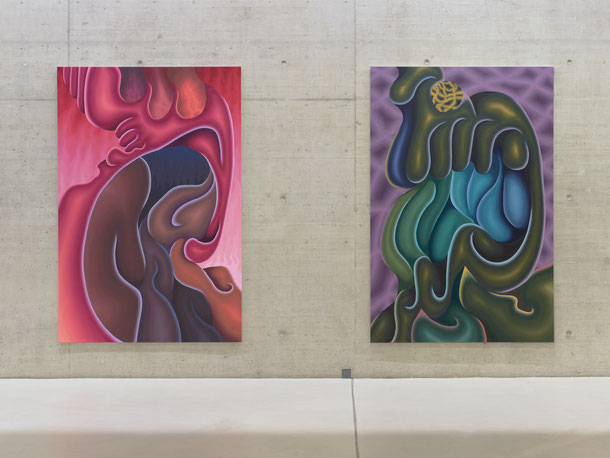
Wie es weiter geht, wissen wir nicht
Ist es möglich, dass jedes Atom ein ganzes Universum in sich trägt? Und kann unser Universum gleichzeitig ein Atom eines größeren Lebewesens sein?
So wie wir Menschen uns in diesen unbegreiflichen Fragen verlieren können, so verlieren wir uns auch in Antonia Freisburgers bildgewaltigen Form- und Farbwelten. Tiefrote Wellen weichen gezwirbelten Strängen, die im unendlich erscheinenden Hintergrund langsam verschwinden. Organische Knoten reihen sich aneinander, strahlend pinke Wolken und grüne Tropfen stülpen sich übereinander. In diesem Konglomerat an Formen und Mustern, wie etwa in Phynobell (2023) oder Whyohya (2023), bietet sich den Betrachter*innen eine Welt, in diesie sich körperlich hineinziehen lassen können. Sie vermitteln eine monistische Vorstellung von Innerem und Äußerem. Zwischen dem uns Menschen ungreifbaren außerirdischen Kosmos – dem Universum – und den endlosen Innenwelten von Lebewesen mit all ihren Atomen, Molekülen und Elementarteilchen, ihren organischen Formen, den Venen, Adern, Blutgefäßen und Knorpeln. Auch Atome haben eine Innenstruktur, sie haben Elektronenschalen, deren Verbindungen teilweise verzerrt sind und sie besitzen einen Kern. Diese Kerne wiederum bestehen aus Nuklearbausteinen, Protonen und Neuronen – Strukturen, Formen und Muster, die wir in Freisburgers großformatigen Malereien wiederzufinden scheinen.
Zugleich eröffnet sich uns eine gar dystopische Landschaft. Eine Dystopie in Form apokalyptischer Weltuntergangsszenarien, die womöglich näher bevorstehen als vermutet. Wie es weiter geht, wissen wir nicht.
Bei Fragen, welche Formen das Leben in Zukunft noch annehmen kann, stoßen wir schnell an einen kognitiven Grenzmoment. Unsere Vorstellung ist endlich, basierend auf dem, was wir bereits wissen und kennen. Diese unbeantwortbaren Fragen können manchmal eine Form von Trauer auslösen. Trauer darüber, wie klein und unwissend wir sind, wie grenzenlos der Kosmos und wie limitiert gleichzeitig unsere Vorstellungskraft ist.
Antonia Freisburger erkennt gerade in diesem ambivalenten Moment der Ungreifbarkeit und bevorstehenden Bedrohung das Schöne. Sie selbst vergleicht es damit, was wohl tiefreligiöse Menschen empfinden müssen. Dass es etwas gibt, dass so viel größer ist als wir selbst. Ein Blick in den Sternenhimmel und wir wissen, was sie meint. Ein Gedanke, der traurig und düster, aber eben schön zugleich sein kann.
Der Entstehungsprozess dieser Form- und Farbwelten ist nahezu immer gleich. Ein bis zweimal im Jahr füllt Freisburger ein Skizzenbuch mit stark intuitiven Formskizzen. Im Zeichnen gerät sie dann in einen fast rauschartigen Zustand, in dem alle Formen und Gestalten, Wellen und Knoten intuitiv auf das Papier gebracht werden können. Ihre Intuition bildet hierbei gleichzeitig bereits die Basis der Komposition, denn einen Rahmen setzt sie von Anfang an fest. Später im Atelier überlegt die Künstlerin, welche der Skizzen sie davon in die großformatige Malerei umsetzen kann. Die Flüchtigkeit der Skizzen weicht nun einem pedantischen Regelwerk – das Farbspektrum muss genauestens überlegt werden, alle Farben im Bild müssen sich aufeinander beziehen und wiederholt auftauchen. Die Formen werden von einer unsichtbaren Lichtquelle angestrahlt und überlappende Farbflächen werden mit Terpentin millimetergenau entfernt.
Auch wenn die Künstlerin ihre Arbeiten teils in Serien unterteilt, ist doch jedes ihrer Gemälde absolut einzigartig. Die Malerei bietet Antonia Freisburger die größtmögliche Freiheit der Darstellung. Sie ist nicht abhängig von der Materialität, wie etwa bei der Bildhauerei, in der die Materialoberfläche eine direkte Einordnung erfordert. Warum ist es hart und glänzend oder rau und glatt?
Für sie könnte in der dreidimensionalen Umsetzung viel von der Offenheit verloren gehen, die sie in der Malerei findet. Einzig eine Übertragung auf digitale Medien wäre eine Option – aber auch nur, wenn die Offenheit und Gleichzeitigkeit von „es kann alles sein und alles bedeuten“ bestehen bleibt.
Der Versuch, diesen Grenzmoment des Unvorstellbaren darzustellen, – zu verstehen, was unsere kognitiven Grenzen übersteigt – ist für Antonia Freisburger nicht nur ein gedanklicher Akt, sondern geht auch in eine physische Erfahrung über. Das Gemälde (-Un) (2023) etwa stellt einen sehr intimen Prozess dar, den eigenen physischen und psychischen Schmerz auszudrücken. Dem Hören von Musik kommt dabei ebenfalls eine große Bedeutung zuteil. Düstere Richtungen wie beispielsweise der Black Metal, voll Verzweiflung und menschlichen Abgründen, lösen für sie starke Gefühle von Trauer und Schmerz über den Verlust der Welt aus.
Dann holt die Musik in ihr hervor, was unterbewusst schon vorhanden war, und lässt sie sich verstanden fühlen in ihrem Schmerz. Eine körperliche Grenzerfahrung, eine physische Komponente, in der sie sich völlig losgelöst von allem Irdischen fühlt, und dennoch ein essenzielles Gefühl von Leben hervorbringt, wie auch immer man „Leben“ definieren mag.
Eine weitere physische Ebene eröffnet sich Antonia Freisburger, wenn sie mit dem Ausstellungsraum selbst arbeiten kann. So etwa mit der großformatigen Papierrolle Hyper-Eli (2023) auf dem Boden des KIT oder früheren ähnlichen Arbeiten.
Sie will auf die Räume reagieren, Arbeiten entstehen lassen, die nur für den Ort gedacht sind. Das großformatige Zeichnen auf dem Boden oder an der Wand ist so einnehmend, dass Freisburger an ihre körperlichen Grenzen gelangt. Es erlaubt ihr, sich einem Arbeitsprozess hinzugeben, der nunmehr rein intuitiv und körperlich ist. Ohne Gedanken und Regelwerk überlässt sie sich dem Fluss, bringt wiederholte Zeichen, Formen und Linien auf das Papier. Es wird für sie zu einem heilsamen Prozess, in dem Formen entstehen, die sie so auf der Leinwand nicht hätte verwirklichen können. Für sie eine Out-of-Body-Experience – OOBE, wie sie auch eine ihrer Raumarbeiten 2022 betitelt. OOBE oder im Deutschen AKE (Außerkörperliche Erfahrung) ist ein ähnlich der Autoskopie definierter psychologischer Zustand, in dem man sich während körperlicher Grenzerfahrungen und Bewusstseinszuständen – etwa unter Drogeneinfluss oder starkem Schlafmangel – selbst von außen betrachtet.
Wenn wir vor Antonia Freisburgers Bildwelten stehen, blicken wir dann auch auf uns selbst?
Als wären wir Außerirdische, vermitteln ihre Werke die Ungreifbarkeit allen Lebens, so dass es nicht nur wehmütig macht, sondern auch ein gewaltiges Gefühl von Schönheit generiert.
Dr. Luisa Seipp
Katalogtext „I‘ve Got You“, KIT - Kunst im Tunnel, Düsseldorf, 2023
Trust Issues
Galerie Droste, Düsseldorf, 2023
Genesis
the Address Gallery, Brescia, Italy, 2023
Säulen Säumen
Herzogstraße 89, Düsseldorf, 2022
High Weirdness
Solaris Space, Berlin, 2022
High Weirdness
When we consider something to be weird it’s usually a thing we can’t explain, a thing we don’t understand. Weird is unsettling, can be horrifying, but also fascinating. ‘High Weirdness’ deals
with the feeling of ‘weird’interpreted by three different artistic perspectives.
Antonia Freisburger’s paintings remind me of the tempting smoothness and pastel colours of impossibly chewy candies. At the same time I’m terrified of being submerged in their sticky surface
which seems to exist in a dimension incomprehensible to human minus. Antonia’s paintings make you loose the sense of time and scale, they conjure feelings like those of cosmic horror- a slip of
the mind and suddenly you’re aware and terrified of things that are way beyond your understanding and control. Standing in front of her vast canvases you might get the feeling of being sucked
into a strange universe of pulsating colours, of glowing and expanding shapes that are difficult to define with words, as though they don’t belong to earthly vocabulary. They have a sort of
viscosity that makes makes you feel like you stuck in there and similarly to escaping the quicksand–the more you try to move the more you become trapped. Antonia’s work makes me think of the idea
of ‘Hyperobjects’- a term coined by Timothy Morton to describe entities such as environmental threats (for example radioactivity, global warming, styrofoam but also capitalism) with the impact so
massively expanded in time or space, that it can’t be fully grasped by an individual. […]
Gosiah Lehmann
Solaris Space, Berlin, 2022
YUBI
sonneundsolche, Düsseldorf, 2022
Tardyonic Ripple
8BRÜT, Düsseldorf, 2022
CONTINUUM
das Odradek, Düsseldorf, 2021
Extrapolation
Künstlerverein Malkasten, 2020




